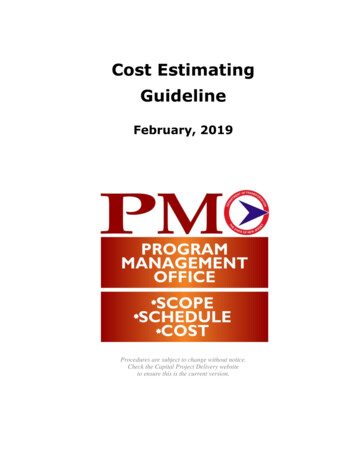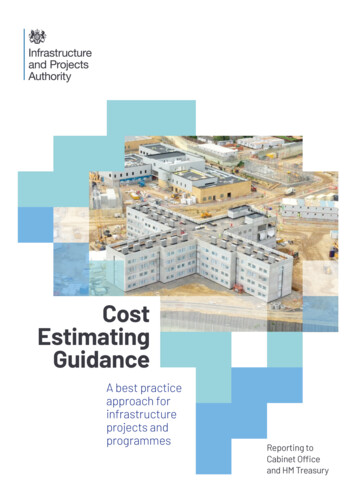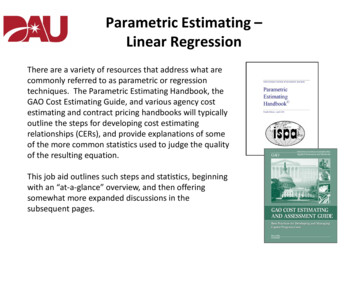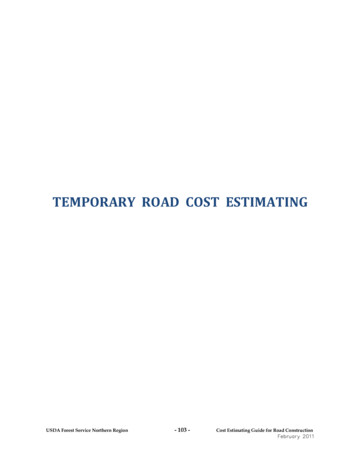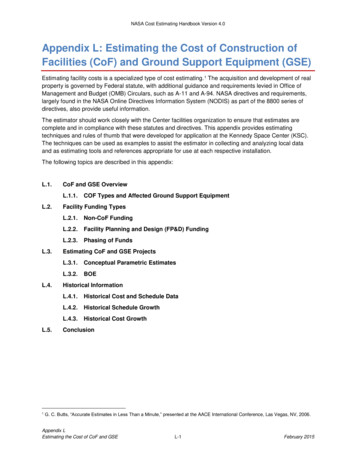
Transcription
NASA Cost Estimating Handbook Version 4.0Appendix L: Estimating the Cost of Construction ofFacilities (CoF) and Ground Support Equipment (GSE)Estimating facility costs is a specialized type of cost estimating. 1 The acquisition and development of realproperty is governed by Federal statute, with additional guidance and requirements levied in Office ofManagement and Budget (OMB) Circulars, such as A-11 and A-94. NASA directives and requirements,largely found in the NASA Online Directives Information System (NODIS) as part of the 8800 series ofdirectives, also provide useful information.The estimator should work closely with the Center facilities organization to ensure that estimates arecomplete and in compliance with these statutes and directives. This appendix provides estimatingtechniques and rules of thumb that were developed for application at the Kennedy Space Center (KSC).The techniques can be used as examples to assist the estimator in collecting and analyzing local dataand as estimating tools and references appropriate for use at each respective installation.The following topics are described in this appendix:L.1.CoF and GSE OverviewL.1.1.L.2.L.3.L.4.L.5.1COF Types and Affected Ground Support EquipmentFacility Funding TypesL.2.1.Non-CoF FundingL.2.2.Facility Planning and Design (FP&D) FundingL.2.3.Phasing of FundsEstimating CoF and GSE ProjectsL.3.1.Conceptual Parametric EstimatesL.3.2.BOEHistorical InformationL.4.1.Historical Cost and Schedule DataL.4.2.Historical Schedule GrowthL.4.3.Historical Cost GrowthConclusionG. C. Butts, “Accurate Estimates in Less Than a Minute,” presented at the AACE International Conference, Las Vegas, NV, 2006.Appendix LEstimating the Cost of CoF and GSEL-1February 2015
NASA Cost Estimating Handbook Version 4.0L.1. CoF and GSE OverviewIt can be difficult to estimate costs for CoF and GSE due to many factors, including numerous variationsof types, sizes, unique features, site location, site conditions, economic conditions, and localinfrastructure capability. Federal law and NASA Facility Project Requirements, including NASAProcedural Directive (NPD) 8820.2D, dictate a rigid budget process for CoF projects that requires thatCoF funding requests be submitted years before the design has been completed or final requirements areknown. Figure L-1 captures the funding process. For more specific details on NASA policy and the CoFprocess, refer to NPD 8820.2D at http://nodis3.gsfc.nasa.gov/lib docs.cfm?range 8.Figure L-1. The CoF Funding ProcessL.1.1.COF Types and Affected Ground Support EquipmentCongressional authorization and appropriations are required for the funding of revitalization projects,construction of new facilities, acquisition of related collateral equipment, environmental compliancedesign of facility projects, and advanced planning for future facility needs. Preliminary EngineeringReports (PERs) are required for each type of facility need. This includes site investigation and sufficientpreliminary design to fully develop project scope, assess risks, identify construction complexities, andprovide a realistic cost estimate prior to inclusion in the NASA budget submission to the OMB.Here are details on these projects: Revitalization projects—Substantial renewal and upgrade work of the physical plant to meet currentand future needs, thereby extending its useful life (e.g., a facility project that extends the usefulservice life beyond the original design life). Construction of new facilities—The erection or modification of real property required to support a newcapability, including additions, sidewalks, parking lots, driveways, and upgrades. This includesalterations to existing facilities that change the original purpose of the facility (e.g., remodeling awarehouse, or portion thereof, into office space).Appendix LEstimating the Cost of CoF and GSEL-2February 2015
NASA Cost Estimating Handbook Version 4.0 Collateral equipment—Includes building support equipmentCAUTION:and large, substantially affixed equipment/property that isnormally acquired and installed as a part of a facility projectIt is critical for project successthat the correct color of money isand includes the following:allocated! Building-support equipment. Common types of buildingsupport equipment are situated within the facility (e.g.,elevators, transformers, compressors, heaters,ventilators, and air conditioners). It also includes systems and subsystems, such as electrical,plumbing, pneumatic, fire-protection, fire-suppression, control and monitoring systems. Large, substantially affixed equipment/property of any type. Other than building-supportequipment, this type of equipment/property is built in such a way that the installation costsincluding building envelope modifications, special foundations, and utility service exceed 300,000.2 Noncollateral equipment, when acquired and used in a facility or a test apparatus, canbe severed and removed after erection or installation without substantial loss of value or damageto the premises where installed.3 Environmental Compliance—Environmental concerns are becoming a larger factor in the overallprocess, and this trend is only expected to grow. Failure to consider environmental issues will impact aproject’s schedule and, therefore, its budget. All CoF projects require an environmental analysis. 4 Many of these projects require anEnvironmental Assessment (EA), which typically takes from 3 to 8 months to perform. Majorprojects generally require an Environmental Impact Statement (EIS). These typically take 1 to 3years to complete but can run much longer if there are substantial objections from the community. Advanced Planning—Front-end planning to define project requirements using comprehensive planningtools such as the Project Definition Rating Index (PDRI), team building, and other techniques.L.2. Facility Funding TypesThere are three basic types of funding required for facility construction: Research & Development (R&D);CoF ; andFacility Planning and Design (FP&D)Rule of Thumb:Under NASA policy, most CoF projects will require some type ofItems that can easily be moved arenon-CoF funding for activation and non-collateral equipment.usually R&D. Items that cannot beMost facility construction and renovation projects require multipleeasily moved are usually CoF.funding types for completion.Demolition funding is unique: it can sometimes be CoF- or nonCoF-funded depending on the specific circumstances. Forexample, if an entire building is to be demolished, it can be done with CoF funding even though items inthe building may be classified as R&D. However, if, for example, the demolition is for something initiallybuilt with non-CoF money, then non-CoF funding could be used for demolition. Table L-1 gives examplesof CoF and non-CoF items.2NASA Facility Project Requirements, NPF 8820.2F Appendix A, paragraph A-23.http://nodis3.gsfc.nasa.gov/lib docs.cfm?range 83NASA Facility Project Requirements, NPF 8820.2F Appendix A, paragraph A-86.http://nodis3.gsfc.nasa.gov/lib docs.cfm?range 8414 CFR Part 1216 (http://www.access.gpo.gov/nara/cfr/waisidx 00/14cfr1216 00.html) and NPR 8820.2F paragraph 1.3.16.7.Appendix LEstimating the Cost of CoF and GSEL-3February 2015
NASA Cost Estimating Handbook Version 4.0L.2.1.Non-CoF FundingNon-CoF funds are used for noncollateral equipment such as furniture, carpeting, telephone systems,GSE, and Special Test Equipment (STE). Other non-CoF costs include relocation/move-in expenses andcalibration.Table L-1. Example Comparison of CoF and Non-CoF ItemsExamples of CoF Items Building structure (foundation, walls, roof, etc.) Vinyl tile and ceramic tile Heating, ventilation, and air conditioning (HVAC)systems Alternating current (AC) power Electrical conduit Fire-detection system hardware Fire-suppression systems Potable water Wastewater systems Facility gas systems (from source to facility 5-foot line) Facility grounding and lightning protection Cranes (including control systems and softwareprograms) Elevators (including control systems and softwareprograms) Exhaust systems Cabling duct banks (power and communications) Emergency power generation Original finished flooring and ceiling Signs (except personnel name signs)L.2.2.Examples of Non-CoF Items ActivationFurniture and window treatmentsCarpetingSystems furnitureElectronic equipment racksRemovable raised flooringRaised flooring and Heating, Ventilation and Air Conditioning(HVAC) for raised flooring systems (equipment racks,computers, data equipment)GSEHardline tubing and flexible hoses from facility 5-foot-lineinterface panel to GSECommunication cable (including data circuits) and “end item”equipmentTelephonesComputersFire-detection softwareApplication softwareLaboratory equipment and systems, including work benches,sinks, cabinets, and exhaust “hoods”Uninterruptible Power Systems (UPS)Direct Current (DC) powerPremise wiringOperational Intercom System—Digital (OIS-D)Cafeteria and kitchen equipment/furnitureLabor for connecting facility interfacesFacility Planning and Design (FP&D) FundingFP&D funding is a hybrid of non-CoF and CoF funding, but it must be clearly established early duringPre–Phase A Formulation.Design is the cornerstone of any project. A good design is crucial for meeting the project’s schedule,scope, and budget requirements. A poor design may not adequately cover the requirements of theproject. If the drawings are incomplete, ambiguous, unclear, or open to interpretation, the contractor willinterpret specifications and requirements to its benefit, increasing the number of change orders that willoccur later and driving up cost.L.2.2.1.CoF Design FeesIn addition, 2 percent of the CCE may be required for a Preliminary Engineering Report (PER), and 2percent may be required for a study. The Federal Acquisition Regulation (FAR) prohibits payment of morethan 6 percent of the CCE for the actual design; however, the remaining 4 percent is allocated for sitevisits, design reviews, and other costs.Appendix LEstimating the Cost of CoF and GSEL-4February 2015
NASA Cost Estimating Handbook Version 4.0In practice, the higher the project costs, the smaller the designbudget percentage should be in relation to the total cost.Consequently, the smaller the project, the larger the designbudget should be in relation to the total cost. Smaller projectsrequire a basic amount of work, including weekly meetings, sitevisits, and submittal review. It takes just as long to review a floorcovering submittal for a 1,000-square-foot building as for a 1million-square-foot building, but on the larger projects, there areenough fees to cover this activity.CAUTION:The line between CoF and non-CoFcan be unclear and difficult todetermine. There can be severeconsequences for errors. InvolveCenter CoF Program Managers andHeadquarters early, and documentyour assumptions!Engineering News Record (ENR) has proposed a new feedetermination formula in an attempt to adjust for these issues:Basic Services Design Fee 1.25/(Log C)1.5where C current construction cost in dollarsBasic Services Design fee percentage valueHowever, the proposed new fee-determination formula does not hold up against actual design feesnegotiated at KSC. The following formula is a better fit for the average of 44 projects at KSC:Y 16.73 x0.37The formula estimates a 66 percent probability for design costs to not exceed the calculated amount. Toincrease the probability of not exceeding the calculated amount by 84 percent, the formula needs to bemodified as follows:Y 16.73 x-0.34The calculated amounts by project costs are shown in Figure L-2.Rule of Thumb:If the project is 10 percent non-CoFand 90 percent CoF, 10 percent ofthe FP&D funding will be R&D and 90percent will be CoF funded.Exception: Facility planning fundingis always non-CoF funding.Appendix LEstimating the Cost of CoF and GSEL-5February 2015
NASA Cost Estimating Handbook Version 4.022Power (GB y 16 * x -0.34)20Power (Average y 16.728 * x -0.3706)18Power (ENR y 1.25/(Log x) 1.5)FP&D of Low Bid w Bid Price ( M)Figure L-2. FP&D Fee CalculationsThe estimator needs to remember that the relationship used to estimate FP&D fees should be applicableto the specific Center and site being evaluated.Note that the FP&D fees for new projects are, on average, 1 percent higher than modifications to existingprojects. This is attributed to the required EIS. Also, technically complex projects generally require ahigher design fee than indicated in Figure L-2.According to the Means Estimating Handbook, design and architectural fees range from 15 percent forsmall or complex projects down to 4 percent for large projects or projects involving uncomplicated orrepetitive work.5L.2.2.2.GSE DesignThe design of GSE typically costs more than normal building design costs. Historically, the range of finalcosts for the design of GSE has been 1 to 212 percent of the total bid, mainly due to the variety of itemsand quantities ordered. Only one design and 50 copies of the same item may be built; or, it is conceivablethat only one unique item is ordered.Rule of Thumb:Rule of Thumb:Normal GSE design cost is 10 to 50percent of the total GSE cost.5The smaller or more unique theequipment, the higher the GSEdesign cost.Means Estimating Handbook, Second Edition, Reed Construction Data, 2003, p. 20.Appendix LEstimating the Cost of CoF and GSEL-6February 2015
NASA Cost Estimating Handbook Version 4.0L.2.2.3.Design DurationThe industry average for the duration of the design phase for projects between 500,000 and 5 million is8 months, but at KSC, the design phase averages 10 months due to design changes, unforeseenconditions, new requirements, etc.A recent American Institute of Architects (AIA) survey of architecture firms determined that the averagetime between the award of a design contract and the award of a construction contract for a facility wasabout a year. However, there is considerable variation from project to project. According to the AIAsurvey, for commercial/industrial projects, the design phase up through contract award was less than 6months for 40 percent of the projects, while for more than a quarter of projects, this period extendedbeyond a year. The size and complexity of a project are key reasons for variation in design time, but threeother factors also influence design time: Client decision making—and whether these decisions need single or multiple approvalsFinancing and funding for the projectRegulatory approvals—land entitlement, special-use permits, zoning, environmental issues, andhistorical considerationsL.2.3.Phasing of FundsOnce the total project budget has been determined, the next step is phasing funding correctly. This iscritical for project success! Unless special permission is obtained for a Limit of Government Obligation(LOGO) contract, all funds estimated for the contract award are required to be transferred to theCenter before the contract can be awarded, even though money may not be spent for years. Rely onyour Center experts to determine optimum fund phasing, but if time does not allow, Table L-2 and TableL-3 are offered as guidelines.Table L-2. Typical Fund-Phasing for Small, Simple Projects with Values Less Than 10 MillionItemEnvironmental ImpactTypicalRange1–3%Rule ofThumb1%FP&DMinimum of 3 years before 7–83%57%CoF & R&DMinimum of 2 years before constructionawardMinimum of 1 year before constructionawardBudget Year (BY) of award8–15%12%CoF & R&DBY of award0–30%20%R&DOutfitting is BY, and activation is typically 1year after awardConstructionConstructionServices7Outfitting and Activation86Color of Year RequiredSee the design section for more information.7Funding for Supervision, Inspection, Engineering, and Services (SIES) and support requests from support contractors.8Whatever is required to make the facility fully functional.Appendix LEstimating the Cost of CoF and GSEL-7February 2015
NASA Cost Estimating Handbook Version 4.0Table L-3. Typical Fund-Phasing for Larger, More Complex ProjectsItemStudy9TypicalRange1–3%Rule ofThumb2%Color of Year RequiredR&DMinimum of 3 years before awardEnvironmental Impact1–3%2%FP&DMinimum of 3 years before awardPER102–5%2%FP&DMinimum of 2 years before awardDesign5–15%8%FP&DMinimum of 1 year before awardConstruction29–71%46%CoF & R&DYear of awardConstruction Services8–15%12%CoF & R&DYear of awardOutfitting and Activation0–30%20%R&DOutfitting is BY, and activation is typically 1year after awardL.3. Estimating CoF and GSE ProjectsWhen the need for a CoF or GSE project is identified, the first question is, usually, how much will it cost?The usual progression is similar to Figure L-3.Need IdentifiedHow Much?Project AcceptedDesign Process Requirements compiled Usually sparse May be erroneous Requirements compiled Assumptions made Estimates performed Estimates reviewed Study or design allocated Detailed estimates usuallyperformed with design Requirements andassumptions firm upProject RejectedDetailed Estimate Needs and requirementsreassessed Assumptions firmer Estimates performed Estimates reviewed Iterated several timesProject CompletedFigure L-3. CoF and GSE Estimating ProcessThis appendix focuses on the “How Much?” portion of Table L-3 since there are many books availablethat discuss the “Detailed Estimate” portion of the process.L.3.1.Conceptual Parametric EstimatesConceptual parametric estimates are typically done at the beginning of a project. Parametric estimatesuse comparable historical project cost data, which are adjusted to fit the known new project parameters.The costs are then escalated using a cost index to determine how much it would cost to construct thesame project today. Although it sounds simple, numerous variables must be taken into account, such aschanges to building codes, Americans with Disabilities Act (ADA) requirements, site-specific conditions,design changes, new security requirements, location, size, and implementation approach (competitive9The study typically gathers requirements, examines alternatives, and prepares estimates for each option.10The PER starts the initial phase of design.Appendix LEstimating the Cost of CoF and GSEL-8February 2015
NASA Cost Estimating Handbook Version 4.0firm-fixed price, small business set-aside, cost plus, etc.). Meticulous record keeping and a strong Basisof Estimate (BOE) are required to effectively execute this type of estimate.L.3.1.1.Potential Problems with Conceptual Parametric EstimatesThe biggest problems encountered with conceptual estimates are the lack of defined projectrequirements, optimistic assumptions, or the failure of project management to acknowledge probablerequirements due to the expense associated with them. Figure L-4Error! Reference source not found.compares a 1974 Shuttle operations concept, left, with the reality of what was actually built, right.Figure L-4. Shuttle Operations 1974 Concept Versus RealityA common, overly optimistic facilities assumption is that funds will arrive at Centers on the first day of thenew fiscal year (FY). In fact, over a recent 5-year period, FP&D money showed up on average 4.6months into the FY, and CoF funds arrived on average 7.3 months into the new FY. This issue willimmediately impact costs if the project “assumes” an October 1 start. If the project deadline is fixed, theproject will need to be accelerated to meet the same completion date.The estimator should identify the level of accuracy that can be expected based on the project informationgiven. The Standard Classification for Cost Estimate Classification System, from the American Society forTesting and Materials (ASTM), offers some guidance for this purpose.11 Figure L-5 shows the expectedaccuracy of complex project estimates over time. Note that on the x-axis, C-30 means 30 percentcomplete, C-60 means 60 percent complete, etc. Routine simple projects are expected to achieve betterresults.11ASTM E2516-11, ASTM Standard Classification of Cost Estimate Classification System, April 2011.Appendix LEstimating the Cost of CoF and GSEL-9February 2015
NASA Cost Estimating Handbook Version 4.0200%Delta From "Correct"150%100%50%0%-50%Error Bars 1 Standard DeviationEstimate Stage-100%ROMStudyPER C-30C-60C-90C-95C-100Figure L-5. Expected Average Estimate Accuracy by PhaseExclusions from the estimate should be avoided. If they cannot be avoided, they must be clearly stated.Communication is critical to project success. The estimator should be aware that the project team oftenhas a preconceived cost value for a project (usually low) at the earliest stages of scope definition. Theestimator must prepare an unbiased and realistic estimate based on the scope of work to beaccomplished, and the analyst should not become prejudiced by any preconceived optimism.Another problem in using conceptual estimating methods is relying on the models or Cost EstimatingRelationships (CERs) to produce an estimated value, but neglecting to adjust the calculated costs for theunique aspects of the project being estimated.Often, the estimator fails to fully understand the basis of the historical cost information available. Forexample, if a historical average unit’s cost value of 100,000 per hospital bed were normalized to coveronly hospital costs and not the associated costs for parking structures and related infrastructure, then theestimator would need to be aware of this and adjust the estimates accordingly.L.3.2.Basis of Estimate (BOE)The BOE document is important for conceptual estimates because the Rough Order of Magnitude (ROM)estimate is usually used to obtain project approval and, subsequently, funding. The project’s customermay have a vested interest in concealing information that may substantially affect the project cost, fearingthat if the initial estimate is too high, the project may not obtain approval. However, once the project isinitiated, scope creep can increase the size of the project. When new requirements are added and theproject construction is delayed by the Planning, Programming, Budgeting, and Execution (PPBE) processfor long periods, management will wonder why the ROM estimate was not accurate. In fact, theconceptual estimate may have been very accurate; but the project that was estimated was different fromthe project that was built years later. Documenting the BOE by identifying the scope of the projectestimated, when it will be built, and any other assumptions and cost data used in developing the estimatecan be used to defend the methods used.Appendix LEstimating the Cost of CoF and GSEL-10February 2015
NASA Cost Estimating Handbook Version 4.0L.4. Historical InformationMany estimating methodologies discussed here require relevant historical project cost data. Thesemethods may encompass capacity factors, parametric estimating models, unit costs, or historical projectcosts that can be used as a base case in the derivation of an analogy estimate. A large effort is requiredto gather, sort, and analyze historical project data. Both cost and design scope information must beidentified and collected. It is best to collect the information at the lowest level of detail possible, since itcan always be summarized later if required. After the data have been collected, it should be normalizedfor time, location, site conditions, project specifications, and project scope. Estimates can be preparedquickly if relevant historical project information is available. If you do not have any relevant historicalinformation, consult the following KSC site for data: http://www.ksc.nasa.gov/nasaonly/finance/COST EST/Index.htm. 12Construction companies such as R.S. Means and Marshall &Swift, as well as the Department of Defense (DOD) and manyother organizations, produce square-footage (area) costs forvarious common building types. However, they do not containarea costs for a specialized item, such as a new launch pad ortest stand. Caution must be used since these sources typicallyestimate costs only to the 5-foot line of the facility, and theestimate may not include costs for activation or site-specific,NASA-specific, and infrastructure requirements that drive upcosts.L.4.1.Rule of Thumb:Assume that published area costsmust be increased by 30 to 75percent, depending on the size andtype of facility for uniquerequirements and excluded costs.Historical Cost and Schedule DataFrom initial optimism to changing requirements, NASA has historically had a difficult time meetingscheduled project completion dates within a given budget. One reason for this is that some projectsdevelop incomplete or optimistic schedule plans. For a humorous perspective on the importance ofplanning, John Harvey-Jones,13 chairman of Imperial Chemical Industries from 1982 to 1987, shared hisinsight on consequences of not going through the rigors of planning:Planning is an unnatural process; it is much more fun to do something. The nice thing aboutnot planning is that failure comes as a complete surprise and is not preceded by long periodsof worry and depression.—John Harvey-Jones MBEL.4.2.Historical Schedule GrowthA review of all available historical projects indicates that, on average, GSE schedules slip substantiallyfrom the awarded contract duration.Careful data analysis indicates that for GSE projects, there is delineation between projects that areshorter than 120 days in duration and those that are longer.12The user must be behind NASA’s firewall and within the NASA Data Center (NDC) domain to access this site.13Harvey-Jones was a Member of the Most Excellent Order of the British Empire and host of Troubleshooter on the BBC.Appendix LEstimating the Cost of CoF and GSEL-11February 2015
NASA Cost Estimating Handbook Version 4.0These values were calculated with the following formula:Project Closeout Date – Notice to Proceed (NTP) Date14 Actual DaysActual Days Original Contract Duration Change in Schedule from OriginalFigure L-6 shows the cumulative percent probability that the schedule will slip. For CoF projects, there isa 50 percent probability that a project scheduled to be completed in 120 days or fewer will increase by2.33 times the initial schedule. There is less than a 10 percent probability that the project will becompleted on or before the originally awarded contract duration.2.00ScheduleGrowth 1 331.371.411.451.501.551.621.72120- 181.251.311.391.481.591.731.97Cumulative Probability (%)Figure L-6. Historical GSE Schedule SlipsIt is important to note that these data are only for the duration of NASA-managed projects and do notinclude any delays for design, funding, or procurement activities. Limited anecdotal evidence suggeststhat these delays may be comparable.L.4.3.Historical Cost GrowthMost CoF and GSE projects increase in cost from the time of the award to the time of completion.Changes to the contract after the award are typically more expensive due to two factors: (1) lack ofcompetition and (2) disruption to existing work processes. Contract cost growth and delta from award costare discussed in the next section.L.4.3.1.Historical CoF Contract Cost GrowthThe majority of NASA’s CoF projects incur cost growth over time. The reasons for this are varied andcomplex. The available data are presented here in an effort to enable better planning. The data in FigureL-7 show that for projects that are estimated at 1 million or more, there is less than a 40 percentprobability that the project will be completed for the estimated value. However, since most of NASA’s CoFprojects have a 10 percent contingency, the same project will have a 55 percent probability of completingthe work with the allocated funding.14NTP is similar to Authority to Proceed (ATP).Appendix LEstimating the Cost of CoF and GSEL-12February 2015
Delta from Government Estimate to Completion Cost (%)NASA Cost Estimating Handbook Version 4.080%60%40%20%0%-20%-40%-60%All 28%85%36%90%47%95%66%1 26%31%38%48%65%2 %32%38%47%63%5 40%47%57%74%10 Million 48%64%Cumulative Probability (%)Figure L-7. CoF Estimate Growth Percentage from 100% Design Estimate at CompletionL.4.3.2.Historical GSE Contract Cost GrowthA review of 1,286 GSE items procured for the Space Shuttle program shows that most of these items hadexperienced cost increases from contract award to contract closeout. How much of an increase appearsto depend on the contract size. Typically, it was found that the larger the project, the higher the costgrowth (see Figure L-8).Cost Growth Factor1.40GSE All (1,286 Projects)1.35GSE 25K (651 Projects)1.30GSE 125K (325 Projects)1.25GSE 500K (133 404550556065707580859095GSE All (1,286 .011.021.031.031.041.051.061.081.11GSE 25K (651 .031.041.051.061.071.081.101.121.16GSE 125K (325 .031.041.051.071.081.091.121.151.20GSE 500K (133 .061.081.091.111.131.161.201.251.36Cumula ve Probability (%)Figure L-8. GSE Historical Cost Growth ProbabilityFigure L-9 shows the delta from the final Government estimate and the awarded cost.Appendix LEstimating the Cost of CoF and GSEL-13February 2015
NASA Cost Estimating Handbook Version 4.0Delta from Gov
Appendix L: Estimating the Cost of Construction of Facilities (CoF) and Ground Support Equipment (GSE) Estimating facility costs is a specialized type of cost estimating.1 The acquisition and development of real property is governed by Federal statute, with additional guidance and requir
